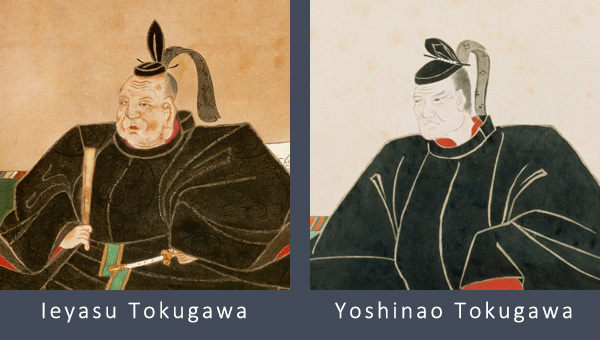About the Owari Tokugawa Family
The Owari Tokugawa family is a daimyō family founded in the early part of the Edo period (1603-1868). It occupied the top of the Gosanke, the three branch families of the Tokugawa clan from which a shogun could be chosen. It had the highest rank among the daimyō (warrior lord) houses under the shogunate.
The first lord of Owari was Yoshinao Tokugawa (1600-1650), the ninth son of Ieyasu Tokugawa. Yoshinao was made daimyō of Owari (today’s western Aichi Prefecture) in 1607 by his father, who commenced construction of Nagoya Castle. As Lord of Owari and parts of the Mino Domain (Gifu Prefecture), Yoshinao oversaw a territory of 619,500 koku gross rice production (a koku is the equivalent of 180 liters of rice, the amount required to feed a man for a year, and the unit by which the worth of a lord’s domain was determined). Because of its important role within the Gosanke (the three branch families of Tokugawa Shogun), the Owari Family was eligible to provide a successor to the Shogun, but in fact the Owari family never did so.
The first lord, Yoshinao, was fond of books and studying, devoted himself to Confucianism, and promoted civilian style policies, while the second lord Mitsutomo (1625-1700) as well as later generations of lords also devoted themselves to scholarly pursuits. The 7th lord, Muneharu (1696-1764), had different political views from the 8th Shogun, Yoshimune, regarding the Shogun’s policy of excessive frugality. Taking a contrary stance, he encouraged local spending which resulted in the prosperity of Nagoya’s castle town, imbuing it with a lively atmosphere and an image as a city of the arts.
Shogun Yoshimune, angered by Muneharu’s actions, ordered his resignation, and the 8th lord, Munekatsu (1705-1761) was brought in from the Takasu Matsudaira Family (one of the branch families of the Owari clan), and installed as successor of the Owari Tokugawa clan. The liberal financial policies of Muneharu’s reign were suppressed, and a crusade of moral reform was undertaken by Munekatsu. This political change was maintained by the 9th lord, Munechika (1732-1799) and from then until the end of the Edo period, the Owari Tokugawa clan continued, led by adopted members from the Shogun’s direct family or from another of the three branches of the Tokugawa house created by the Shogun Yoshimune.
Toward the end of the Edo period, Yoshikatsu Tokugawa (1824-1883), from the Takasu Matsudaira branch of the Owari Tokugawa family, was made the 14th head of the Owari clan. With the Shogun facing problems regarding his succession as well as relations with foreign countries, Yoshikatsu had confrontations with the Tairō (prime-minister) Ii Naosuke, and was ordered to retire. Thereafter, Yoshikatsu’s younger brother Mochinaga (1831-1884) became the 15th head of the clan. After the order of retirement was lifted, Yoshikatsu became an advisor to the 14th Shogun, young Iemochi. His successor, the 15th Shogun, Yoshinobu, later ended the feudal Edo period, turning ruling power of the nation over to the Emperor in 1867. At that time, the 16th Owari Tokugawa Lord was Yoshikatsu’s son, Yoshinori. Although Yoshikatsu had retired by then, he supported Yoshinori from behind the scenes.
Yoshinori died early, and was succeeded by Yoshiakira (1863-1908), later made the 18th head of the Owari Tokugawa clan. He was in turn succeeded by the 19th head, Yoshichika Tokugawa (1886-1976) from the Echizen Matsudaira branch of the clan.
Yoshichika was a scholar, historian, and biologist, and was also active as a politician and entrepreneur. In order to preserve the extensive ancestral collection of traditional artwork, he founded the Owari Tokugawa Reimeikai Foundation in 1931, and four years later established an art museum in Nagoya to preserve and display the treasures of the Owari Tokugawa family. Yoshichika’s heir was Yoshitomo Tokugawa (1911-1992), and his son Yoshinobu (1933-2005) became the 21st head of the family. Later, the current director of the museum, Yoshitaka Tokugawa (1961-), became the 22nd head.

